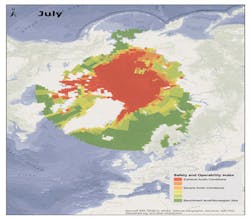Offshore staff
STAVANGER, Norway– DNV GL has developed an interactive Arctic risk map to present the risks associated with offshore and maritime activities in the region. The map aims to provide a comprehensive tool for decision-making and transparent communications.
The map presents multiple dimensions, such as the seasonal distribution of ice, metocean (physical environment) conditions, sea-ice concentrations, biological assets, shipping traffic, and oil and gas resources in a user-friendly, single layout. It also includes a Safety and Operability Index, which shows the variation in different factors that impact the risk level depending on the season and the location in theArctic.
Børre Paaske, project manager at DNV GL – Oil & Gas, said: “The Arctic is not a monolithic area and the risk picture varies accordingly. Stakeholders therefore need a sound decision basis for understanding the risks associated withArctic development and transportation. The DNV GL Arctic Risk Map can help facilitate transparent discussions to address the many dilemmas related to activity in the region.”
In addition, a location- and season-specific index has been developed to show the environmental vulnerability of marine resources with respect to oil spill as an external stressor. In general, DNV GL’s analysis shows that the Arctic environment is characterized by seasonal variations in vulnerability, and that this vulnerability increases in the summer months along with the level of industrial activity. However, this differs greatly between regions.
Elisabeth Tørstad, CEO of DNV GL – Oil & Gas, said: “The risk level in the Arctic must be equivalent to – or better than – the best performance in the industry today. The Arctic’s varied and complex conditions require the industry to take a stepwise approach in which learning and technology are developed progressively regarding the more challenging Arctic areas.”
08/26/2014



